|
|
|
Sort Order |
|
|
|
Items / Page
|
|
|
|
|
|
|
| Srl | Item |
| 1 |
ID:
076429


|
|
|
|
|
| Publication |
2007.
|
| Summary/Abstract |
This paper provides a methodology for estimating the economic impact of defence spending at a sub-regional level. It does so by calculating the income and employment generated by Britain's Royal Navy and associated defence activities in the City of Portsmouth and its surrounding area, during the financial year 2003-2004. In an era of military consolidation, the paper offers an insight into the multifaceted impact of defence-related expenditure. Hence, it presents a generic framework that could prove useful to other researchers when seeking to measure the sub-regional impact of naval, airforce and army facilities in other national contexts
|
|
|
|
|
|
|
|
|
|
|
|
|
|
|
|
| 2 |
ID:
171378


|
|
|
|
|
| Summary/Abstract |
Energy subsidies cost Ecuador 7% of its public budget, or two thirds of the fiscal deficit. Removing these subsidies would yield local economic and environmental benefits and help implement climate targets set in the Paris Agreement. However, adverse effects on vulnerable households can make subsidy reforms politically difficult. To inform policy design, we assess the distributional impacts of energy subsidy reform using Ecuadorian household data and an augmented input-output table. We find that subsidy removal without compensation would be regressive for diesel and LPG, progressive for gasoline, and approximately neutral for electricity. We then analyze how freed up public revenues could fund in-kind and in-cash compensation schemes to mitigate income losses for poor households. Our results indicate that removing all energy subsidies and increasing the cash transfer program, Bono de Desarrollo Humano (BDH), by nearly US$ 50 per month would increase the real income of the poorest quintile by 10% while leaving more than US$ 1.3 billion for the public budget. Finally, we conduct interviews with local policy makers and experts to identify two reform options that are progressive and considered feasible: eliminating subsidies on gasoline while increasing the BDH and replacing universal LPG subsidies with targeted LPG vouchers.
|
|
|
|
|
|
|
|
|
|
|
|
|
|
|
|
| 3 |
ID:
098689


|
|
|
|
|
| Publication |
2010.
|
| Summary/Abstract |
Greater use of renewable energy is being aggressively promoted to combat climate change by the Chinese government and by other governments. Agricultural straw is the kind of renewable energy source that would become a pollution source if it is not well utilized. We select the Shiliquan straw-based electricity generation project in Shandong Province, China as a case and assess environmental externalities of straw utilization in power plants by using life-cycle analysis. Results show that straw-based electricity generation has far fewer greenhouse gas (GHG) emissions than that of coal-based electricity generation. Improvement in the energy efficiency of equipment used for straw's pretreatment would lead to a decrease of GHG emissions and energy consumption in the life-cycle of straw-based electricity generation. In case 400 million tonnes of wasted straw in China could be used as a substitute for 200 million tonnes of coal, annually the straw 291 Terrawatt hours (TWh) of electricity could be generated, resulting in an annual total CO2 emissions savings of 193 million tonnes. Straw-based electricity generation could be a high-potential alternative for electricity generation as well as an incentive for utilizing wheat straw instead of burning it in the field.
|
|
|
|
|
|
|
|
|
|
|
|
|
|
|
|
| 4 |
ID:
175255
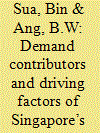

|
|
|
|
|
| Summary/Abstract |
Singapore is an island city state. It lacks conventional energy resources and is alternative energy disadvantaged. Yet its aggregate carbon intensity, given by the ratio of carbon emissions to GDP, dropped by 30% from 2005 to 2014. Currently it has a relatively low carbon intensity. Using I–O analysis, we study Singapore’s aggregate carbon intensity and the factors contributing to its changes at different levels, i.e. final demand, sector, and transmission levels. It is found that domestic exports accounted for nearly two-thirds of Singapore’s aggregate carbon intensity, followed by private consumption and investment. At the sectoral level, the top three contributors were the petroleum, petrochemical, and land transport sectors. Improvements in emission intensity and final demand structure were major factors contributing to reductions in carbon intensity. Our study contributes to the literature in two aspects. Methodologically, it deals with embodied emission intensity and analyzes its changes from the demand perspective. This differs from most studies in the literature from the production perspective. Empirically, the findings and policy implications are unique as they are applicable to a major city. With urbanization taking place in many developing countries, cites’ role in emissions and environmental sustainability are growing in importance but not many in-depth analyses similar to our study have been reported.
|
|
|
|
|
|
|
|
|
|
|
|
|
|
|
|
| 5 |
ID:
163560
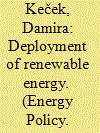

|
|
|
|
|
| Summary/Abstract |
Energy strategy of the European Union and Croatia specify the focus on generating energy from renewable sources as an important basis for achieving sustainable development. The aim of the paper is to quantify economic effects of the renewable energy sources plants deployment in Croatia. Indirect and induced effects of deploying and operating such plants have been quantified based on an input-output model. Whereas the open input-output model quantifies indirect effects, the model closed by individual consumption additionally includes induced effects related to the increase in income of the household sector. The total effects have been quantified separately for the investment channel and the channel of intermediate consumption. The results indicate that there are positive multiplicative effects related to the deployment and operation of the plants based on renewable sources in Croatia. The same amount of investments results in the highest gross value added and employment for smaller hydropower plants and biogas, whereas multiplicative effects of the wind power plants are lower due to the high share of imported equipment. The policy of fostering renewable sources will potentially have more intensive effects on the national economy if the energy and industrial strategy are better harmonised in the future.
|
|
|
|
|
|
|
|
|
|
|
|
|
|
|
|
| 6 |
ID:
162322
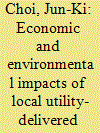

|
|
|
|
|
| Summary/Abstract |
Manufacturing operations are constantly encouraged to include energy-efficient practices into their plant operations, including through rebate programs that provide monetary rewards for firms who purchase and employ energy-efficient equipment in their facilities. This article presents a novel methodology for analyzing the cascading economic and environmental effects of an electric utility company's industrial energy-efficiency rebate programs and applies it to the case of a local utility located in the U.S. state of Ohio. It examines the utility's industrial rebate programs for lighting, motor, and heating, ventilation, and air conditioning (HVAC) systems and estimates the economic and environmental impacts of the programs using an input-output modeling framework. All three rebate programs provided a modest economic boost not only to directly involved equipment manufacturers and marketing service providers, but also to other upstream industries responding to the direct impact and the final demand augmented by the associated increase in value added in the regional economy. Emissions avoided as a result of electricity savings were found to outweigh additional emissions generated from the production of the energy-efficiency equipment in the region throughout the program years. However, if the full equipment purchase data were made available, the amount of added CO2 emissions would be larger.
|
|
|
|
|
|
|
|
|
|
|
|
|
|
|
|
| 7 |
ID:
169311


|
|
|
|
|
| Summary/Abstract |
The market structure of government investment domination in the space industry is being disrupted as commercial companies began working in the commercial space sector. As the 1960s was known as a government-funded space race, the 21st century may be known as a private interest space race. U.S. policy intended to speed innovation and drive costs down by expanding the role of commercial space companies. Hence, the 2018 orbiting sports car, yet more importantly, reusable rockets, satellites, and associated services developed as a result of the deliberate shift in government policy starting with the Commercial Space Launch Act of 1984.
|
|
|
|
|
|
|
|
|
|
|
|
|
|
|
|
| 8 |
ID:
091701


|
|
|
|
|
| Publication |
2009.
|
| Summary/Abstract |
This paper aims at developing an integrated approach for estimating the employment benefits associated with power-generation technologies. The proposed approach exploits the input-output methodology for estimating the direct, indirect and induced employment effects associated with the energy project in question, as well as two different valuation techniques, namely the "opportunity cost of labour" approach and the "public expenditures" approach, for expressing these effects in monetary terms. This framework has been implemented to estimate the employment benefits resulting from the development of a lignite-fired and a natural gas-fired power plant in Greece, taking into account all the stages of the corresponding fuel cycles that are undertaken domestically. The results of the analysis clearly show that lignite-fired electricity generation results in significant employment benefits amounting to 2.9-3.5 €/MWh in the basic scenario. On the other hand, the employment benefits associated with the examined natural gas unit were estimated at 0.4-0.6 €/MWh in the basic scenario. It is also worth mentioning that the significant environmental externalities of the lignite-fired electricity in Greece that have been presented in a number of studies can only be partially compensated by the estimated employment benefits.
|
|
|
|
|
|
|
|
|
|
|
|
|
|
|
|
| 9 |
ID:
124688


|
|
|
|
|
| Publication |
2013.
|
| Summary/Abstract |
In order to uncover driving forces for provincial CO2 emission in China, a case study was undertaken to shed light on the CO2 emission growth in such a region. Liaoning province was selected due to its typical features as one industrial province. The environmental input-output analysis and structure decomposing analysis have been conducted in order to provide a holistic picture on Liaoning's CO2 emissions during 1997-2007. Research outcomes indicate that rapid increase of per capita consumption activities is the main driver for Liaoning to have a significant CO2 emission growth, followed by consumption structure, production structure and population size. Energy intensity and energy structure partly offset the CO2 emission increase. Electricity power and heat supply and construction sectors caused the most CO2 emission, indicating that more specific mitigation policies for these two sectors should be prepared. From final demand point of view, it is clear that trade plays a leading role in regional CO2 emission, followed by fixed capital investment and urban household consumption which become increasingly important over time. Consequently, in order to realize low carbon development, local governments should consider all these factors so that appropriate mitigation policies can be raised by considering the local realities.
|
|
|
|
|
|
|
|
|
|
|
|
|
|
|
|
| 10 |
ID:
098692
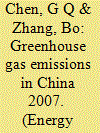

|
|
|
|
|
| Publication |
2010.
|
| Summary/Abstract |
For greenhouse gas (GHG) emissions by the Chinese economy in 2007 with the most recent statistics availability, a concrete inventory covering CO2, CH4, and N2O is composed and associated with an input-output analysis to reveal the emission embodiment in final consumption and international trade. The estimated total direct GHG emission amounts to 7456.12 Mt CO2-eq by the commonly referred IPCC global warming potentials, with 63.39% from energy-related CO2, 22.31% from non-energy-related CO2, 11.15% from CH4 and 3.15% from N2O. Responsible for 81.32% of the total GHG emissions are the five sectors of the Electric Power/Steam and Hot Water Production and Supply, Smelting and Pressing of Ferrous and Nonferrous Metals, Nonmetal Mineral Products, Agriculture, and Coal Mining and Dressing, with distinctive emission structures. The sector of Construction holds the top GHG emissions embodied in both domestic production and consumption, and the emission embodied in gross capital formation is prominently more than those in other components of the final consumption characterized by extensive investment in contrast to limited household consumption. China is a net exporter of embodied GHG emissions, with emissions embodied in exports of 3060.18 Mt CO2-eq, in magnitude up to 41.04% of the total direct emission.
|
|
|
|
|
|
|
|
|
|
|
|
|
|
|
|
| 11 |
ID:
177339
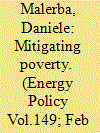

|
|
|
|
|
| Summary/Abstract |
Carbon taxes are an economically effective and efficient policy measure to address climate change mitigation. However, they can have severe adverse distributional effects. Recycling parts of the fiscal revenues to vulnerable, lower income households through cash transfers (social assistance) is an option to also overcome associated political difficulties. This paper simulates the distributional impacts of such a combined policy reform in Peru. In a first step, we assess the distributional impacts of varying carbon tax rates. In a second step, we evaluate different scenarios of recycling revenues through existing or expanded transfer schemes towards vulnerable households. The results indicate that a national carbon tax, without compensation, would increase poverty but have no significant impact on inequality. When tax revenues are recycled through transfer schemes, however, poverty would actually decrease. Depending on the amount to be redistributed and the design of the cash transfer scheme, our simulations show a proportional reduction in the poverty headcount of up to around 17%. In addition, the paper underlines how crucial it is to go beyond aggregate measures of poverty to better identify losers from such reform; and assure that the “leave no one behind” principle of the Sustainable Development Goals (SDGs) is addressed.
|
|
|
|
|
|
|
|
|
|
|
|
|
|
|
|
| 12 |
ID:
179744


|
|
|
|
|
| Summary/Abstract |
As part of the sustainable energy transition in Germany, substantial investments in power grid infrastructure are planned. They are intended to provide flexibility to an electricity system increasingly relying on variable renewable energy sources, and on European interconnection. While much research has been done on the benefits of renewables, the economic impact of the necessary grid investments so far remains widely unclear. This paper presents a macroeconomic assessment of the planned investments in power grid infrastructure in Germany. By performing a static input-output analysis, the investigation reveals how multiplier effects of the grid investments impact macroeconomic outcomes – in terms of output, value added, employment and fiscal income. Net multiplier effects on outputs are found to be positive, ranging between €47.3 bn and €55.8 bn, while other effects turn out to be negative. A net decrease in value added of between €10.1 bn and €12.7 bn, in fiscal income between €962 million and €1354 million, and reductions in employment of between 130,170 and 158,940 jobs are found to be attributable to the grid investments. Hence, from a national perspective, the planned investments are found to have mixed macroeconomic effects and are not necessarily 100% 'no-regret'. Flexibility investments for the energy transition provided by power grids should therefore be realized with caution, and at least cost, if negative effects on national value added, tax revenues and employment are to be minimized. For policy guidance, more research is needed on the relative merits of the flexibility options available for accomodating high shares of renewables, and on the overall economic net benefits of sustainable energy transitions.
|
|
|
|
|
|
|
|
|
|
|
|
|
|
|
|
| 13 |
ID:
124589


|
|
|
|
|
| Publication |
2013.
|
| Summary/Abstract |
Consumption accounting of urban greenhouse gas emissions is preferable to production accounting, because cities are open systems which depend on the import of large quantities of externally produced goods. In this paper we use environmental input-output analysis to construct CO2 production and consumption accounting inventories for Xiamen, a rapidly developing coastal city in southeast China. We found that, in 2007, total emissions embodied in production were 21.8 Mt CO2, of which 17.1 Mt CO2 were embodied in exports and 4.7 Mt CO2 resulted from local demand on local production. If the large amounts of emissions embodied in the Xiamen reprocessing trade are excluded from the analysis, total imported emissions were 12.2 Mt CO2, consumption emissions were 16.9 Mt CO2, and Xiamen was a net exporter of 4.9 Mt CO2. Although Xiamen's rapid economic growth is dependent on large-scale flows of embodied emissions, most of these emissions are not produced or consumed within the city system.
|
|
|
|
|
|
|
|
|
|
|
|
|
|
|
|
| 14 |
ID:
101157
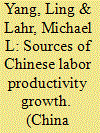

|
|
|
|
|
| Publication |
2010.
|
| Summary/Abstract |
We decompose labor productivity growth from 1987 to 2005 by examining six partial factors (both supply and demand): changes in value-added coefficients, labor inputs, shares of sectoral demands that are fulfilled domestically, input mix, and the intra-sectoral shares and intersectoral mix of final demand. Our analysis confirms that simply by virtue of its size and extremely low level of labor productivity, China's farm sector continues to weigh heavily in China's overall economic advances. Labor savings have levied the largest influence on the labor productivity on all sectors across all three study subperiods. We find that this transition is highly correlated with capital deepening that accompanies China's opening up process. Still, changes in the intra-sectoral shares and the intersectoral mix of China's final demand also have become quite strong, especially in recent periods. Due to ever-increasing competitive pressures as China continues to open, changes in industries value-added coefficients have tended to counteract some of the positive benefits of labor savings for most sectors. The effects on changes in labor productivity of technology change and changes in the use of imports have been comparatively negligible and any variation in their sectoral effects have been waning over time.
|
|
|
|
|
|
|
|
|
|
|
|
|
|
|
|
| 15 |
ID:
185730
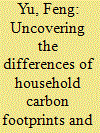

|
|
|
|
|
| Summary/Abstract |
Household carbon footprint is closely related with economic development level. Thus, to reveal the characteristic of household carbon footprint and its driving forces for countries under different development stage, this paper compared household carbon footprint and driving forces of developing China and developed Japan using input-output method and structural decomposition analysis method. Results show that China's household carbon footprint increased rapidly from 939 megatons (Mt) in 1997–3363 Mt in 2015, and then gradually decreased, while Japan's household carbon footprint fluctuated between 700–1000 Mt. In terms of per capita indirect household carbon footprint, it increased fast in China, but was still only less than 1/4 of that in Japan in 2018. Another finding is that food carbon footprint will decrease, while housing carbon footprint will increase with economic development. Transportation & communication can be a potential source for reducing such carbon footprints. In terms of driving forces of household carbon footprint, consumption expenditure was the major positive driving force and technology was a major negative driving force in China, while Japan was mainly driven by technology. It is suggested to pay attention to control the per capita household carbon footprint of fast developing countries, particularly transportation & communication consumption.
|
|
|
|
|
|
|
|
|
|
|
|
|
|
|
|
| 16 |
ID:
176740
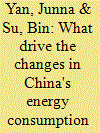

|
|
|
|
|
| Summary/Abstract |
During the 12th Five-Year Plan Period (2011–2015), the Chinese government has released a series of energy conservation plans to launch and deepen the transition in the energy use. Particularly, the dual control of the energy consumption and energy intensity was firstly emphasized. This paper intends to explore the targeted and effective energy policy implications through investigating the drivers of changes in energy consumption/intensity of China during the 12th Five-Year Plan Period. Under the input-output framework, the embodied energy consumptions/intensities by final demand category were estimated at aggregate/sector level and the total energy consumption/intensity was decomposed using the additive/multiplicative structural decomposition analysis. Among the final demand categories, China's energy consumption/intensity was mainly contributed by the investment, followed by the household consumption. According to the SDA results, China's total energy consumption increased by 28.8%, of which the energy intensity effect and the investment effect were the most retardant and accelerator, respectively. At the same time, China's total aggregate energy intensity decreased by 16.0%, of which the energy intensity effect and the household consumption effect were the most retardant and accelerator, respectively. In detail, the key sectors with respect to the critical effects were picked out. Above all, policy implications are discussed for achieving the energy goals during the 13th Five-Year Plan Period and launching the energy revolution during the 14th Five-Year Plan Period.
|
|
|
|
|
|
|
|
|
|
|
|
|
|
|
|
| 17 |
ID:
130976


|
|
|
|
|
| Publication |
2014.
|
| Summary/Abstract |
In the present study, five stylized facts about China's producer services are established through international, intersectoral and intertemporal comparisons based on input-output tables. First, the overall service input ratio is the lowest in all the sample economies. Second, most producer services are supplied by the traditional labor-intensive sectors. Third, manufacturing is the biggest user of producer services, and service industry is the second, while the opposite is true for most of the other sample economies. Fourth, unlike other economies, China's "R&D" is characterized more by consumer services than producer services. Fifth, China has fairly lower service input ratios in almost all the industries. The backward and forward linkages coefficients are both smaller for "real estate activities" and "finance and insurance." Policy reform should focus not only on specific producer services but also on reducing obstacles that are inhibiting the balanced development of diverse producer services that will help China to optimize its economic structure.
|
|
|
|
|
|
|
|
|
|
|
|
|
|
|
|
|
|
|
|
|